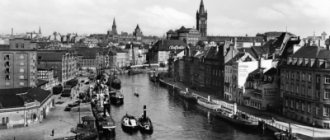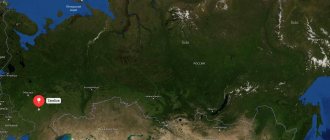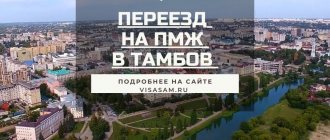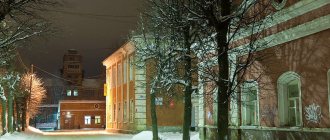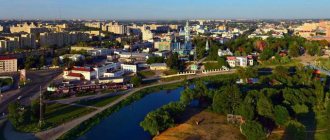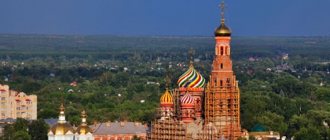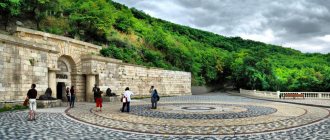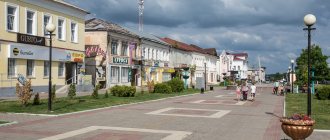| Tambov |
Tambov
, a city in Russia, the administrative center of the Tambov region and the Tambov Metropolis, the cathedral center of the Tambov diocese. Located on the Tsna River (Oka basin), 460 km southeast of Moscow. Population 283.8 thousand (2012).
- On the map: Yandex.Map, Google map
The city was founded on April 17, 1636 on the marshy, wooded banks of the Tsna River, in the place where the Studenets River merges with it. By decree of Tsar Mikhail Fedorovich, steward and governor Roman Boborykin began construction of the fortress city of Tambov to protect the Moscow state from nomads. The original name of the city was written “ Tonbov
” and was associated with the supposed site of the founding of a fortress on the Lipovitsa River “opposite the extreme Mordovian village of Tonbov” and the Tonbov River. Although the city was founded in a different place, it retained its original name. The root of the word is most likely of Moksha origin (“tonbo” - whirlpool). The fact of the founding of Tambov is reflected in an ancient chronicle written in 1788 by an unknown author.
As the borders of the Russian state moved south, Tambov by the end of the 17th century lost its former significance as a military guard fortress. In 1708, Tambov, as a district city, was assigned to the Azov province. Its connections with Moscow, the cities of the Black Earth Region and the Volga region are expanding.
In 1719, it became the center of the Tambov province, which became part of the Azov province, later (in 1732) renamed the Voronezh province. In 1779, it became the administrative center of the Tambov governorship, which in 1796 became known as the Tambov province. The province included 13 cities.
In the middle of the 19th century, the construction of stone buildings began in Tambov - a guest courtyard, government offices, a men's gymnasium and the Alexander Institute. The formation of the city center ended at the end of the 19th century with the construction of the Naryshkin reading room, the building of the State Duma and the Assembly of the Nobility.
In the 19th century, Tambov was a major center for grain wholesale trade. Industry developed slowly and in 1913 it provided only 2% of the total industrial output of European Russia. Before the October Revolution, the largest enterprises in Tambov were railway workshops (800 workers) and a candle factory (85 workers). In addition to them, there were about 30 small semi-handicraft factories.
The February and October revolutions of 1917 took place quite peacefully in Tambov.
In August 1919, during the civil war, the city was captured by the cavalry of General Mamontov. In 1920-21, the city was engulfed in a peasant uprising led by A.S. Antonov.
In 1928, the Tambov province was included in the Central Black Earth Region, and with the dissolution of the Central Black Earth Region in 1934, it was included in the Voronezh Region.
In 1937, the Tambov region was formed, which included the territory of the Penza and Tambov regions; in 1939, the boundaries of the region were revised.
During the Great Patriotic War, a large number of hospitals were opened in the city, and the city was bombed.
Religion
The Tambov diocese was founded in 1682, abolished in 1720 and restored in 1758.
By the end of the 1930s, the Tambov diocese was completely destroyed. There is not a single active parish left on its territory. The restoration of the diocese began in October 1943, when the first church was opened in Tambov.
On December 26, 2012, the Tambov Metropolis was established.
The Saints
- St. Pitirim Tambovsky (+ 1698), bishop. Tambovsky from 1685 to 1698
- St. Feofan (Govorov), Recluse (+ 1894), bishop. Tambovsky from 1859 to 1863
- Sschmch. Zechariah (Lobov) (+ 1937), archbishop. Voronezh, studied at Tambov theological schools from the 1870s to 1886.
- Sschmch. Kirill (Smirnov) (+ 1937), archbishop. Tambovsky from 1909 to 1918
- Sschmch. German (Ryashentsev) (+ 1937), bishop. b. Vyaznikovsky, native
- Sschmch. Vassian (Pyatnitsky) (+ 1940), archbishop. Tambovsky from 1930 to 1936
- Schisp. Luke (Voino-Yasenetsky) (+ 1961), archbishop. Tambovsky from 1944 to 1946
Monasteries
- Voznesensky (female)
- Kazan (male)
Temples
- Alexandra Rimskaya, at Tambov State University. G.R. Derzhavina
- “Joy of All Who Sorrow” icon of the Mother of God, Church of the Ascension Monastery
- St. George the Victorious, chapel
- John the Evangelist, baptismal church
- John Chrysostom, at the former Tambov Theological School
- John of Kronstadt, Church of the Ascension Monastery
- John the Baptist, temple of the Kazan Monastery
- Kazan Icon of the Mother of God, Cathedral of the Kazan Monastery
- Metropolitan Kirill and Luke (Voino-Yasenetsky), cross church
- Cyril and Methodius, seminary house church of the Kazan Monastery
- Lazarus of the Four Days
- Nicholas the Wonderworker at the former Tambov Theological Seminary, house church
- New Martyrs and Confessors of Russia
- Panteleimon the Healer at the hospital named after St. Luke (Voino-Yasenetsky)
- Peter and Paul
- Pitirim Tambovsky, chapel
- Protection of the Blessed Virgin Mary
- Transfiguration of the Lord, Cathedral
- Seraphim of Sarov, at the former II Tambov Theological School
- Seraphim of Sarov, in the Raduzhny microdistrict (under construction [1])
- Sophia, the Wisdom of God, at the first building of the former II Tambov Theological School (abolished)
- Trinity Life-Giving
- Dormition of the Blessed Virgin Mary, church-chapel
- Feofan the Recluse (under construction [2])
Educational establishments
- Tambov Theological Seminary
Geographical position
Tambov is located at the confluence of the Tsna and Studenets rivers.
In the 17th century, when the city was founded, Studenets was full-flowing, and Tsna was a stream. Now the situation has changed dramatically. The student is drying up, now it is a stream that partially flows through pipes under the city. And Tsna is noticeably wider and has an equipped embankment. The region is located in the forest-steppe. In the area of the Don and Volga watershed. About 10% of the territory of the Tambov region is covered with forests. Of course, the region is famous for its black soils. These are the most nutrient-rich soils on Earth.
Tambov black soil
Tambov coat of arms
The city first acquired a coat of arms in 1730. The background is blue at the top, green at the bottom (about 1/4). Symbolizes the sky and green grass. On top of the background is a golden beehive with three bees fanning above it. Which reminds us of the hard work of the inhabitants, the richness of nature and the harmony of the inhabitants. In addition, beekeeping has long been practiced in Tambov and local honey was famous throughout Russia.
Tambov coat of arms
Tambov has one of the oldest coats of arms in Russia. However, during Soviet times, the city’s coat of arms was deprived of official status.
Tambov is waiting for guests, ready to show and tell its story related to protection, defense and boundaries. Now the city is quiet, well-kept, pleasant to visit at any time of the year.
Transport in Tambov
Public transport is represented by buses, trolleybuses and minibuses. Trolleybus routes pass mainly only through the city center. The situation with transport is quite complicated. While communication in the center and north is not poorly established, it is very difficult to leave for the Letka or White Tank areas after 19:00. In the southern part and Stroitel village, buses run relatively well. However, in the evening, waiting at the bus stop for half an hour is considered the norm.
The fleet of buses and trolleybuses is being replenished and updated. New routes are being organized. But the measures do not yet cover the needs of all areas of the city. Therefore, taxis are used here willingly and often.
Interesting Facts
About marriages
In the 18th–19th centuries. neither the groom nor the bride played any roles during the marriage. Everything was decided by the parents. There were frequent cases of men and women marrying at a very young age, and the man was often several years younger than the woman.
Examples:
- Kozlovsky district, village of Chelnavsky Otrozhek, 1801, single-yard son Andrei Miletin - 11 years old and his wife Praskovya Moiseeva - 20 years old;
- Morshansky district, village of Vyshenki, 1801, son of Kondrat Kharitonov Agap - 12 years old and his wife Nastasya Fedulova - 17 years old;
- Kozlovsky district, Podgornoye village, 1801, Zot Arkhipov’s son Stepan, 11.5 years old, and his wife Avdotya Mikhailova, 19 years old...
About celebrities
Born in Tambov:
- Sergei Rachmaninov – composer, pianist,
- Boris Chicherin – lawyer, philosopher, historian and publicist,
- Zoya Kosmodemyanskaya - partisan of the Great Patriotic War,
- Yuri Zhirkov is a football player, winner of the UEFA Cup, bronze medalist of the 2008 European Football Championship, champion of England.
- Alexander Pushkin’s wife Natalya Goncharova was also born in the Tambov region.
- Impressed by the city, Mikhail Lermontov wrote the poem “Tambov Treasurer” in 1838.
- Cosmonaut Sergei Volkov graduated from the Tambov Military Flight School in 1995, now disbanded.
- The governor of the Tambov province from 1786 to 1788 was Gavriil Derzhavin.
About chemical weapons
In 1920, a peasant uprising took place in the Tambov region. It is also called “Antonovsky” - after the name of one of the leaders of the uprising. The Soviet government was able to suppress it almost only a year later. This was the first time in history that the government used chemical weapons against an insurgent population.
About cinema
Feature films were shot in Tambov, including “The Fate of a Man” by Sergei Bondarchuk and “Once Upon a Time There Was a Woman” by Andrei Smirnov.
About the press
It was in Tambov that the first provincial newspaper in Russia appeared. It was called “Tambov News”.
About the Tambov wolf
The wolves settled in the Tambov region belong to the species of common gray wolves, widespread in the nature of Russia. There is no specific “Tambov” subspecies of wolf.
The Tambov wolf is one of the most popular souvenirs brought as a keepsake of Tambov by guests and residents of the city.
The expression about the Tambov Wolf gained wide all-Union fame after the film “The Rumyantsev Case” was released from cinema screens in 1955. In this film, the catch phrase sounded - “The Tambov wolf is your comrade!” This phrase was said by a police officer in response to an appeal from the artist Alexei Batalov, who played the role of a driver in the film.
Over many years of difficult and bloody struggle with the nomads, our ancestors noticed an interesting feature: horses, which formed the main striking force in the armies of the steppes, were afraid of the smell of wolves. This horse feature was skillfully used by the defenders of the Tambov strongholds. Tambov warriors went into battle against the Tatar and Nogai hordes, having previously put on fresh or untreated wolf skins over their armor. The Tatar horses sensed the scent of wolves and instinctively sought to turn back. The skin of the Tambov wolf, brought to England by some of the first merchants who visited the Russian state on trade visits, is now exhibited as an exhibit in the Museum of the British Royal Horse Guards.
During the Great Patriotic War, many wolves were forced to migrate from places disturbed by military operations to the territory of the Tambov region. Old people say that during the war the number of wolves in the Tambov region was simply enormous. Starving predators completely
lost fear of man. Even during daylight hours, wolves were not afraid to approach the house itself, attack dogs, sneak into barns and kill livestock (my grandmother also told me this).
Did you know that...
- The territory of the Tambov region can be compared with the area of Belgium and the Netherlands.
- The rivers of the Tambov region belong to the Volga and Don basin.
- at the end of the 19th century, Tambov residents drank water that was one of the best in Russia.
- Not far from Tambov there is Lake Chistoe, from which water periodically disappears. When it fills with water again, floating islands appear on it, on which rare plants grow.
- automobile traffic in Tambov began in 1911 (the first car was owned by the provincial secretary A.D. Gerasimov), in 1916 there were already 2 cars in the city.
- It is known that both sides of the street are called the same. but there is an exception. There is a street whose sides have different names. It starts from the street. Gastello, and goes north. The left side is called the street. Serov, and the right - District.
- The first buses ran in the city in 1928, and trolleybuses in 1955.
- Opposite the railway station there is now the Friendship of Peoples fountain. But it was not always so. In the 19th century there was a park there, planted with poplars, where visitors rested. And later a full-length monument to J.V. Stalin was erected there.
Story
The history of Tambov begins on April 17, 1636. On this day, the sovereign voivode Roman Boborykin founded a stronghold of the Moscow state. Thanks to economic preferences, the territory was actively populated by peasants. In 1779, by decree of Catherine II, the governorship of the same name was formed. Soon it was transformed into a province. Grain trade began to flourish there.
In the first half of the 19th century, educational and public institutions appeared. The Bolsheviks' rise to power was accompanied by peasant uprisings. The rebels seized lands and opposed the arbitrariness of the rulers.
Industrialization was marked by the commissioning of industrial enterprises. After the end of World War II, new industries emerged. Residential areas, plants, and factories were built. As part of the Russian Federation, the pace of development has slowed down.
Climate of Tambov
The region is located in the temperate continental zone. Seasonality is pronounced. The weather conditions are quite favorable for life. The average temperature in January is about -11 °C, in July +20 °C. The climate zone is characterized by insufficient moisture. About 50-60% of all precipitation in a year occurs during the growing season. It is sunny in Tambov, the number of hours of sunshine is almost the same as in the Caucasian resorts. This situation provokes droughts. Additionally, sometimes dry winds blow. In general, winters are relatively mild and snowy. In summer it is sunny and hot.
How to get to Tambov
It is convenient to travel from Moscow by train. The following trains departing from Paveletsky Station passing through Tambov:
- 565B "Moscow - Saratov"
- 263M "Moscow - Balakovo"
- 379Y "Moscow - Kamyshin"
- 005G "Moscow - Astrakhan"
- 045M "Moscow - Tambov"
- 085B "Moscow - Makhachkala"
- 343Zh "Moscow - Balashov"
The schedule is updated, depends on the season, train numbers may change. There is one railway station in Tambov. The journey from Moscow by train will take approximately 7 to 12 hours.
It is also possible to travel from Moscow by bus. There are quite a few direct flights, departing from the Central Bus Station or Varshavskaya Bus Station. In addition to direct flights, the final stop of which is Tambov, buses pass through the city to the following cities:
- Uryupinsk
- Volzhsky
- Volgograd
- Derbent
- Makhachkala
The road from Moscow to Tambov by car takes about 6-8 hours. At an average speed of 80 km/h. You need to cover a distance of 458 km.
Route to Tambov from Moscow on the map
The road surface is now in good condition, you can drive quite comfortably. Motorists warn that there are few roadside cafes on this road and the quality of their service leaves much to be desired. Alternatively, stock up on food with you.
There is an airport in Tambov that accepts passengers on Wednesdays and Saturdays. Air flights have been established from the following cities:
- St. Petersburg (Pulkovo)
- Ekaterinburg (Koltsovo)
- Krasnodar (Pashkovsky)
Economy of Tambov and the region
During the Soviet years, many chemical and defense industry enterprises operated in the city. During the collapse of the 90s, Tambov, like many cities in the Russian Federation, went through difficult times. For example, the once large one could not survive and in some years completely curtailed its activities. Now the company is organizing its work, producing window profiles and other consumer goods, but there are no previous production volumes, the plant is not considered a reliable employer among local residents.
Tambov plant Komsomolets
Chemical industry enterprises operate successfully: Tambovpolimermash and Tambovsky - a large, stable enterprise, wages are above the average in the city. Some engineering enterprises were also unable to maintain high production volumes. and Tambov Oktyabr Plant have greatly reduced production capacity. Currently working, retooling and looking to grow. The repair and construction enterprise "Vagonremmash" is an important part of the Tambov economy.
Pigment is the largest enterprise that produces paints and varnishes, additives for gasoline and concrete, bleaches, special chemicals, etc. The company is part of the Krata industrial group.
The group plays a significant role in the city’s economy and unites a number of manufacturing enterprises:
- ARTI-Rezinoplast;
- "Tambovgalvanotekhnika" named after. S. I. Livshitsa;
- ARTI-Plant.
Unlike industry, the food industry in the region is quite well developed. There are full-cycle agricultural enterprises. Products are grown in our own fields. Recycled on site. Livestock is fed with feed produced in-house. From the resulting meat, high-quality sausages, delicacies and various meat products are produced on site. The quality of the products is really decent and the price is at a comfortable level. Tambov residents highlight the Maksimovsky meat processing plant and the Zhupikov production enterprise. The confectionery shop is operating steadily. It operates a chocolate museum, where they conduct not only excursions, but also children's parties and master classes.
Procurement of feed for livestock
Trade in the city is developing rapidly. New shopping centers are opening. A distinctive feature of Tambov shopping centers is that many of them are opened in former industrial premises. Since after the collapse of the 90s a large number of industrial enterprises fell into disrepair, the areas were not used. As the city has grown, now some of the premises are located in the first lines of the central streets, with convenient parking. For shopping centers, this turned out to be a convenient opportunity not to invest heavily in construction, but to modernize existing former workshops with high ceilings and good communications for the needs of trade. Examples of such shopping centers that appeared in former industrial premises:
- Shopping center Europe;
- Shopping center Carnival;
- Shopping center Auchan;
- Shopping center Akson and a number of others.
